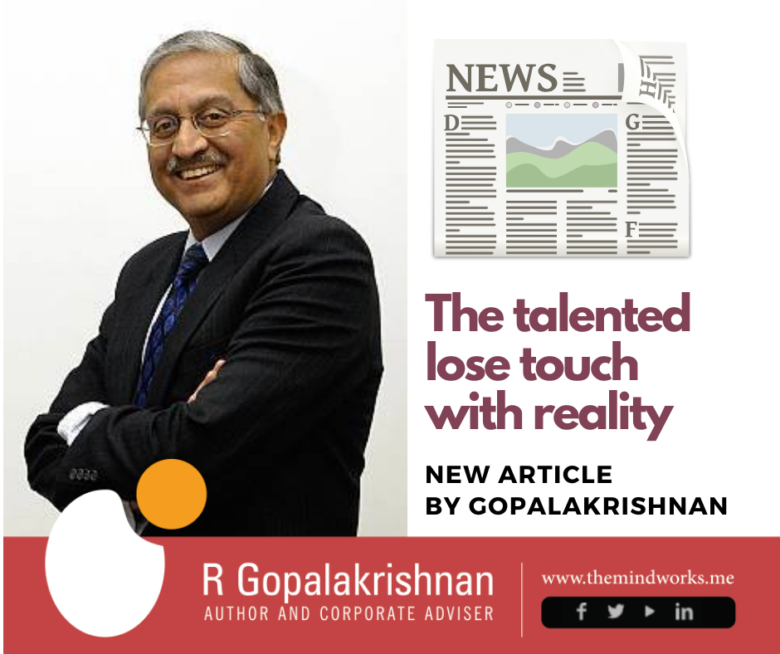13th June, 2018 BUSINESS STANDARD
R. Gopalakrishnan
Email: rgopal@themindworks.me
*The writer is a corporate advisor and Distinguished Professor of IIT Kharagpur. His new book, “CRASH: lessons from the rise and exit of business leaders” will be published by Penguin India in September 2018.
Because of testing protocols, promising food innovations sometimes fail to make it to the market. There needs to be an international protocol for testing innovations that impact Mother Gaia.
Fantastic and successful innovations carry unintended consequences, which can convert those innovations into a ‘curse’–think of fertilizers, insecticides, automobile and atom. Within the next thirty years, there will be a clamor to ban or control televisions, cell phones and computers, which generate enormous electronic waste. I recall a wunderkind of my childhood, plastic.
In Greek mythology, Gaia is the Earth and one of the primordial deities. In Hindu mythology, Bhoomi is the Sanskrit name for the earth, Bhoodevi being the consort of Lord Vishnu. Since our ancients did conceive of the earth as a goddess, it is not stupid to consider the earth as a human being. It is educative and interesting to apply the principle of safety testing of products for human consumption to innovations that will impact the earth. If such a protocol were to exist, there would be a discipline to spreading innovations that are commercialized.
Plastics, invented and scaled up after WW II, have served society diligently for over half a century. If there were a protocol to test the effect of plastics on Gaia, there would have been a mature restraint in proliferating its use. Over 9,200 million tonnes of plastics have been produced since 1950. Perhaps two thirds sits on land, rivers and oceans, burdening Mother Gaia. Plastics cannot be “digested” by the stomach of Mother Gaia. Digestion means the material gets absorbed through biological means, quite different from recycling, which merely improves the longevity. Recycling is good, thank you, but after exhausting reuse options, plastic will sit in landfills, roads and buildings, rivers and oceans as a permanent burden on the planet. In India, it is estimated that about 40% plastics are film and food packaging, which clog rivers and pipes, causing the equivalent of diarrhea in the anatomy of Mother Gaia.
We are now at a stage where we cannot do without plastics, nor can we continue with it–like smoking or drinking. In food and drugs, the product innovator has to follow international protocols of safety testing. The results are reviewed by a publicly accountable body. Only after all tests have been completed, permission is granted to introduce the product into the market. This protects consumers and societies from unintended consequences.
Because of such protocols, promising food products sometimes fail to make it to the market. The examples of Haribo and Olestra are briefly recalled in this article. Occasionally, a product makes it to the market, and produces disastrous consequences, like the most distressing and unfortunate case of thalidomide.
Haribo: Haribo Gmbh is a German food company, headquartered in Bonn since 1920. The name of the company was derived from the founder and his city, HAns RIegel BOnn. This long-standing food company
created Haribo’s sugar-free gummy bears. The problem with this sugar-less, yummy-tasting product was that it led to gastro-intestinal distress. A chemically produced sugar replacement called lycasin had been incorporated in the product. Lycasin cannot be fully digested in the human digestive system. Consumers reported that they ‘felt flatulence’ and ‘a violent hurricane’ in their stomach. The lycasin-based product did not make it to the market.
Olestra: A few decades ago, just as sugar became an enemy, so too did oils and fats. P&G invented Olestra, a product that promised binging on cookies and chips without sacrificing taste. Chemically, Olestra was a sucrose polyester/ Food fried in Olestra tasted just as good as other fried food, but the Olestra molecule would pass right through the digestive tract without being absorbed. In consumer terms, it would not ‘stick in the body’. It had an unimaginable potential to be sold to crisp and cola manufacturers. Mercifully the product did not pass FDA tests: it negatively affect vitamin and carotenoid absorption in the human body, apart from causing diarrhea in some cases.
There should be an international protocol for testing innovations that impact Mother Gaia.

